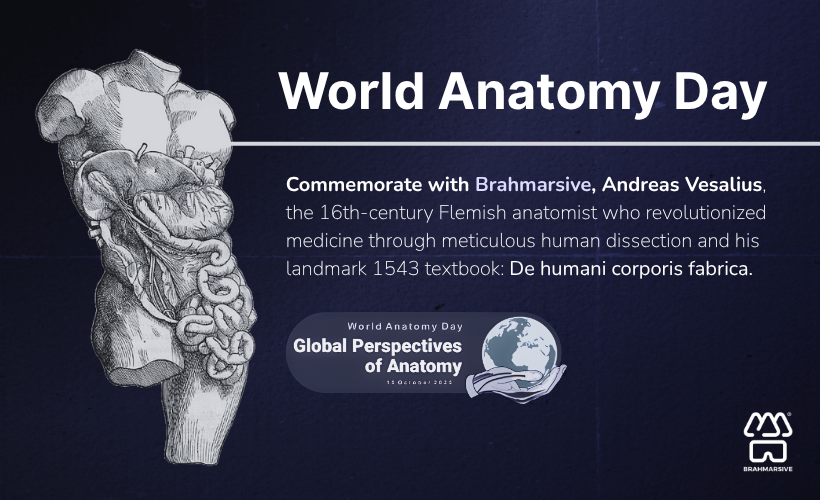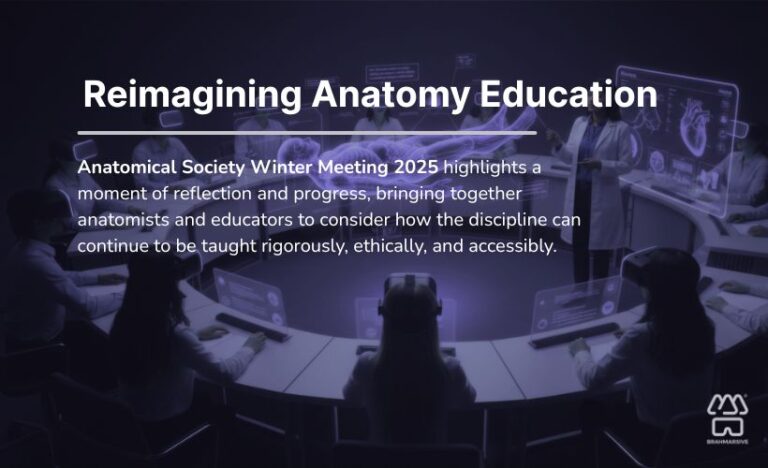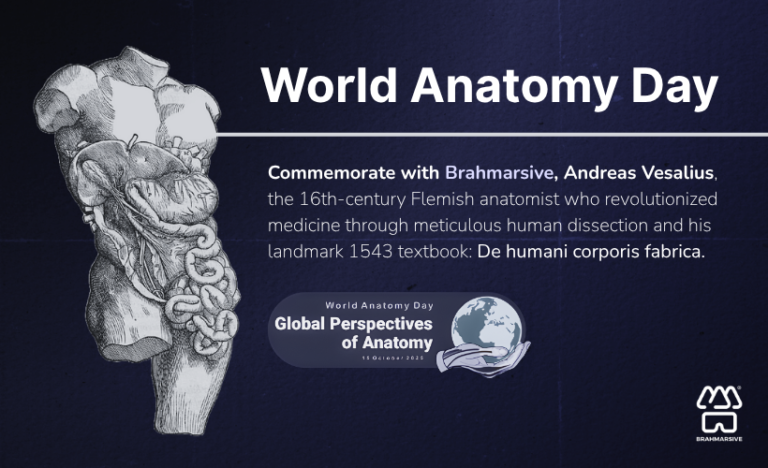Written By: Nicole Cole
Today marks World Anatomy Day 2025, a global celebration of the science that forms the foundation of all medical knowledge.
As anatomy educators, medical students, and healthcare professionals worldwide prepare to honour this day, one thing is clear: we stand at an unprecedented intersection of tradition and innovation, where centuries-old anatomical wisdom meets transformative technology.
Why October 15 Matters
World Anatomy Day commemorates Andreas Vesalius, the 16th-century Flemish anatomist who revolutionized medicine through meticulous human dissection and his landmark 1543 textbook, De humani corporis fabrica. Vesalius passed away on October 15, 1564, but his legacy lives on every time a medical student explores the intricate architecture of the human body.
What makes this year’s celebration particularly significant is how far anatomy education has evolved – from Renaissance anatomy theatres to today’s immersive virtual reality labs. Yet the spirit of inquiry Vesalius championed remains unchanged: a deep curiosity about how our bodies work and an unwavering commitment to understanding human anatomy in ever-greater detail.
Global Perspectives: This Year’s Unifying Theme
The 2025 World Anatomy Day theme “Global perspectives of anatomy: bringing together the global community and recognising differences while celebrating similarities” couldn’t be timelier. This theme emphasizes that while anatomy may be taught differently across continents, languages, and resource levels, our shared fascination with the human body unites us all.
In one country, students might learn through traditional cadaver dissection; in another, they explore digital anatomy platforms. Some institutions have state-of-the-art 3D visualization tools, while others rely on beautifully illustrated atlases. The theme reminds us that diversity in methodology doesn’t diminish our common purpose – it enriches it. Today’s connected world allows anatomists in London, Lagos, and Los Angeles to share knowledge, collaborate on research, and celebrate anatomy together in ways Vesalius could never have imagined.
The Evolution of Anatomy Education: From Scalpels to Headsets
For centuries, anatomy education followed a predictable pattern: cadaver labs, anatomy atlases, memorization of Latin terminology, and hands-on dissection. These traditional methods built the foundation of medical knowledge and remain valuable today. But technology is reshaping how we teach and learn anatomy. Virtual Reality (VR) and 3D anatomy models are creating new possibilities that complement – and in some cases enhance – traditional approaches.
The Digital Cadaver Revolution
Unlike physical cadavers that can only be dissected once, digital cadavers are endlessly reusable, highly detailed 3D models of human anatomy. Students can make virtual incisions repeatedly, explore structures from any angle, zoom in on microscopic details, and reset with a single click giving them unlimited practice opportunities. These platforms offer interactive guidance, embedded quizzes, and instant feedback as learners identify anatomical structures. Many systems now track student progress, enabling educators to monitor performance, identify knowledge gaps, and adjust curricula accordingly. This data-driven approach to anatomy education represents a quantum leap from traditional teaching methods.
Research confirms the effectiveness of this approach. A 2025 study found that students using 3D anatomy models in a blended learning framework scored significantly higher on pre-class and in-class assessments compared to traditional methods, while also reporting greater satisfaction with learning interest and teaching diversity.
VR’s Global Classroom
Perhaps most aligned with this year’s theme is VR’s ability to unite learners across borders. As one recent analysis noted, “The main advantage of VR lies in its capability to simultaneously bring individuals from around the world into one immersive environment, where they can interact, communicate, and even feel as if physically present.” Imagine students in Mumbai, Melbourne, and Montreal simultaneously exploring the same virtual heart model in real time, guided by a professor thousands of miles away. This collaborative VR classroom embodies the World Anatomy Day 2025 spirit – bringing the global anatomy community together while acknowledging that we learn from different perspectives and healthcare systems.
Student Voices: The VR Learning Experience
The enthusiasm from medical students is remarkable. In a 2024 focus group study at UCLA, over 90% of medical students indicated that VR would enhance their anatomy learning experience and help them learn topics better than traditional models. Notably, 94% agreed that this learning modality should be offered to all medical students.
Students consistently praise several aspects of VR anatomy education:
- Visualization and Understanding: Participants highlight VR’s ability to make complex anatomical structures comprehensible. Students note that viewing the heart from different places or exploring the skull interactively provides understanding that textbooks simply cannot match.
- Interactivity and Engagement: The hands-on nature of VR transforms anatomy from a memorization exercise into an active exploration. Students value the autonomy to navigate content at their own pace and discover spatial relationships through direct interaction.
- Real-World Preparation: As one study of midwifery students reported, participants emphasized how VR could enhance understanding of complex topics and compensate for reduced clinical exposure, particularly relevant in our post-pandemic educational landscape.
Dr. Shazia Iqbal, Senior Lecturer at the University of Buckingham, captures the pedagogical significance:
“The integration of Virtual Reality into anatomy education represents a significant pedagogical advancement, fostering active inquiry and deeper conceptual understanding. Within an inquiry-based learning framework, VR enables learners to investigate complex anatomical relationships through experiential exploration, thereby linking theoretical knowledge with clinical application.”
The ROI of Innovation: Why VR Makes Financial Sense
When institutions invest in VR anatomy education, they’re not just buying technology; they’re making a strategic investment with measurable returns across multiple dimensions.
Improved Learning Outcomes
The performance gains are striking. Studies show that surgeons trained using VR simulations demonstrate a 230% improvement in performance compared to those trained with traditional methods. Medical students exposed to VR before high-fidelity simulations complete 6% more critical actions and perform them 28.6% faster than their peers. In anatomy specifically, 75% of comparative studies found VR surpassed traditional teaching methods, including lectures, physical models, and even cadaveric specimens. Students report enhanced conceptual understanding, improved spatial reasoning, and significantly higher confidence in their anatomical knowledge.
Cost Savings and Scalability
While VR requires upfront investment, the long-term economics are compelling. When scaled to more than 3,000 learners, immersive training becomes 52% less expensive than traditional classroom instruction. Physical cadaver labs are expensive to maintain, from specimen acquisition and preservation to facility costs and limited student-to-cadaver ratios. Digital anatomy content, once created, can be accessed by unlimited students without incremental costs. VR also eliminates travel expenses. During the pandemic, institutions with VR infrastructure seamlessly continued training remotely while others struggled with disrupted cadaver labs and cancelled workshops.
Accelerated Training and Higher Retention
VR reduces training time by approximately 75% compared to traditional methods. Students can practice skills repeatedly in compressed timeframes, developing muscle memory and competence faster than lecture-based approaches allow. Critically, VR improves long-term retention. While people forget 70–90% of traditionally learned information within a week, VR training improves knowledge retention by 75%. When students actively engage with life-sized anatomical models in 3D space, the information sticks, they remember spatial relationships and the experiential feeling of exploring anatomy.
Data-Driven Education
Modern VR platforms provide learning analytics that traditional methods cannot match. Educators can track how long students examine specific structures, which anatomical regions cause difficulty, and where knowledge gaps exist. This real-time feedback allows for immediate curriculum adjustments and personalized learning interventions. One university adopting VR simulations over traditional equipment training reported a 60% decline in equipment damage and significantly increased student confidence. Medical schools using VR anatomy tools report faster learning curves, fewer mistakes in clinical settings, and improved patient safety outcomes.
Beyond the Classroom: VR Across Healthcare Training
The impact of immersive anatomy education extends far beyond universities into professional healthcare training and industry applications.
- Clinical Skills and Surgical Training: Residency programs use VR to train clinical skills in risk-free environments. Young surgeons practice complex procedures on virtual patients with anatomically accurate responses, building decision-making skills and muscle memory before entering operating theatres. VR allows infinite repetition until proficiency is achieved – impossible with traditional surgical training.
- Medical Device Training: Device manufacturers increasingly use VR to train physicians on new equipment. Rather than shipping expensive demo units worldwide or flying clinicians to central training facilities, companies provide VR simulations where doctors can virtually operate devices and understand anatomical considerations for positioning and usage.
- Pharmaceutical Education: Pharmaceutical companies leverage VR for immersive education about drug mechanisms. Sales teams and medical liaisons can take virtual journeys inside the human body to see how medications target specific organs or receptors. This is far more engaging than traditional presentations and more effective for understanding complex anatomy and pathology related to therapeutic interventions.
Democratizing Innovation: No-Code VR Creation
A critical development making VR anatomy education accessible to more institutions is the emergence of no-code content creation platforms. Educators without programming expertise can now use drag-and-drop interfaces to design custom VR lessons, modify existing modules, and create interactive assessments tailored to their learning objectives. This democratization means anatomy professors can build VR experiences themselves creating virtual heart explorations with embedded diagnostic challenges, designing custom dissection sequences, or developing anatomy quizzes with 3D models – all without writing code. As these tools mature, VR transitions from expensive novelty to practical educational tool accessible to institutions of all sizes.
A Vision for the Future
Vangili Palaniappan, CEO of Brahmarsive, offers this perspective on where anatomy education is heading:
“Immersive learning has become the cornerstone of modern medical training. When integrated properly, virtual reality allows unparalleled exploration of the human body, letting students and professionals practice in ways previously impossible. Our mission is to democratize this technology through no-code VR content creation and robust learning analytics that deliver measurable outcomes. Meaning, more confident clinicians, improved retention, and cost savings. We’re excited to push the boundaries by combining the wisdom of the past with the innovation of the future.”
Looking Forward
As we celebrate World Anatomy Day 2025, we honour both the remarkable journey of anatomical science and the exciting path ahead. From Vesalius’s groundbreaking dissections to today’s immersive VR experiences, the spirit of inquiry remains constant only our tools have evolved. The future of anatomy education is collaborative, global, and immersive. Whether holding a scalpel or wearing a VR headset, anatomists worldwide share the same wonder at the complexity and beauty of the human body.
Today, take a moment to marvel at how far we’ve come. Share an anatomy fact. Thank a mentor who inspired your journey. If you have access, explore a VR anatomy application. Most importantly, connect with the global community of anatomy enthusiasts celebrating this day.
Happy World Anatomy Day! Let’s honour the past and embrace the future of anatomy – together, in all its wonderous dimensions.
References:
World Anatomy Day 2025 – International Federation of Associations of Anatomists (IFAA) https://ifaa.net/2025/05/05/world-anatomy-day-2025/ Andreas Vesalius: Celebrating 500 years of dissecting nature
PMC https://pmc.ncbi.nlm.nih.gov/articles/PMC4762440/ VR in Medical Training, Education & Upskilling
Lucid Reality Labs https://lucidrealitylabs.com/blog/virtual-reality-medical-education-training-upskilling Exploring Digital Cadavers: A New Era in Medical Education
Brahmarsive https://brahmarsive.com/blog/digital-cadavers-for-anatomy-education/ World Anatomy Day 2025
University of Sunderland https://www.sunderland.ac.uk/more/news/university-news/2025/world-anatomy-day-2025/ World Anatomy Day 2025
University of Birmingham https://www.birmingham.ac.uk/events/the-exchange/125/world-anatomy-day World Anatomy Day 2025
The Anatomical Society https://www.anatsoc.org.uk/news/all-news/2025/04/14/world-anatomy-day-2025 Birbara et al.
Immersive stereoscopic VR study [^50] Enhancing anatomy education with virtual reality
PMC https://pmc.ncbi.nlm.nih.gov/articles/PMC12174101/ [^60] Exploring the promise of virtual reality in enhancing anatomy education
Frontiers https://www.frontiersin.org/journals/virtual-reality/articles/10.3389/frvir.2024.1369794/full [^63] How virtual reality is being adopted in anatomy education
PMC https://pmc.ncbi.nlm.nih.gov/articles/PMC12051093/ [^67] Enhancing anatomy education with virtual reality
Frontiers in Medicine https://www.frontiersin.org/journals/medicine/articles/10.3389/fmed.2025.1555053/full [^68] Ryan et al. VR midwifery education study [^69] Thompson et al. VR anatomy visualization study [^72] ROI of Academic VR Labs
Fusion VR https://www.fusionvr.in/blog/2025/09/12/roi-of-academic-vr-labs-measuring-learning-outcomes-and-student-performance-i n-immersive-environments/ [^73] Virtual reality for improvement of simulation
PMC https://pmc.ncbi.nlm.nih.gov/articles/PMC10884646/ [^78] Immersive Learning ROI: The Cost Effectiveness of XR Training
XR Today https://www.xrtoday.com/virtual-reality/immersive-learning-roi-the-cost-effectiveness-of-xr-training/ [^79] Effective Medical Training: The Impact of VR and AR
EON Reality https://eonreality.com/effective-medical-training-the-impact-of-vr-and-ar/ [^81] The impact of simulation-based training in medical education
PMC https://pmc.ncbi.nlm.nih.gov/articles/PMC11224887/ [^88] Virtual Reality in Medical Education







